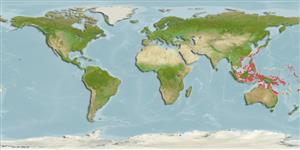>
Ovalentaria/misc (Various families in series Ovalentaria) >
Pomacentridae (Damselfishes) > Pomacentrinae
Etymology: Dischistodus: Greek, di = two + Greek, schistos = fissile stone, Plinius + Greek, odous = teeth (Ref. 45335).
More on author: Bleeker.
Environment: milieu / climate zone / depth range / distribution range
Ecologia
marinhas associadas(os) a recifes; não migratória; intervalo de profundidade 1 - 12 m (Ref. 9710). Tropical; 35°N - 25°S
Western Pacific: southern Japan and the Ryukyu Islands, Taiwan, Philippines, Palau, Indonesia, Papua New Guinea, Solomon Islands, and the Great Barrier Reef. Reported from Vanuatu (Ref. 13300).
Tamanho / Peso / Idade
Maturity: Lm ? range ? - ? cm
Max length : 16.0 cm TL macho/indeterminado; (Ref. 9710)
Espinhos dorsais (total): 13; Raios dorsais moles (total): 13-15; Espinhos anais 2; Raios anais moles: 13 - 14. Adults have a large black patch on the abdomen reaching the anus; juveniles an ocellus over the center of the dorsal fin base (Ref. 48636). Body white, anterodorsal (or sometimes entire half of body) dark brown, opercle spots prominent pale large, belly patch dark brown. Body depth 2.0-2.1 in SL (Ref. 90102).
Adults occur in lagoon reefs and generally prefers small patch reefs with sand or rubble substrates (Ref. 1602). Feed on benthic algae which it aggressively guards against other herbivores (Ref. 9710). Juveniles secretive in rubble (Ref. 48636). Oviparous, distinct pairing during breeding (Ref. 205). Eggs are demersal and adhere to the substrate (Ref. 205). Males guard and aerate the eggs (Ref. 205). Diurnal species (Ref. 113699).
Life cycle and mating behavior
Maturidade | Reprodução | Desova | Ovos | Fecundidade | Larvas
Oviparous, distinct pairing during breeding (Ref. 205). Eggs are demersal and adhere to the substrate (Ref. 205). Males guard and aerate the eggs (Ref. 205).
Allen, G.R., 1991. Damselfishes of the world. Mergus Publishers, Melle, Germany. 271 p. (Ref. 7247)
Categoria na Lista Vermelha da IUCN (Ref. 130435)
Warning: mysqli::__construct(): (HY000/1040): Too many connections in /var/www/html/includes/func_getlabel.php on line 46
Can't connect to MySQL database (fbapp). Errorcode: Too many connections
